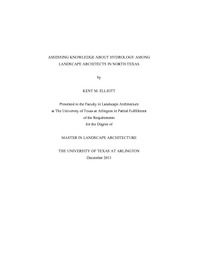| dc.description.abstract | The purpose of this study is to determine the level of knowledge in hydrology a landscape architect needs in professional practice versus the hydrological knowledge, and resulting skill, gained from his or her education. The research also explores the knowledge and skill of other professionals practicing hydrology and determines the amount of knowledge gained by education and practical experience. Finally, the research compares any overlap of knowledge and skill between the professions of landscape architecture and hydrology.Water is a central resource for all economic, social, and environmental activities. Hydrology and other topics such as, supply, demand, and quality are affected by various methods that landscape architects and engineers use to deal with water, including Low Impact Development (LID) and other strategies (ASLA, 2013c; Green, 2012; WWAP, 2012). The Texas Water Development Board (TWDB) predicts an 82 percent increase in population from 2010 to 2060 and a 22 percent increase in water demand. Water shortages cause billions of dollars in economic losses and these losses grow with increased demands and strained water supplies. Large urban areas, such as North Texas, are expected to see larger increases in population than the state average and, therefore, larger increases in demand (TWDB, 2012), The American Society of Landscape Architects (ASLA) includes language about water in its definition of the practice of landscape architecture. Moreover, it is argued that landscape architects are prepared with the knowledge needed to offer services pertaining to water and the hydrological function of land (Adsit, 2012; ASLA, 2003; O'Rourke, 2008; Marsh, 1983). However, little research has been uncovered on the topic of hydrology as a function of landscape architecture. This research followed qualitative methods of inquiry, and used informant interviews to collect data (Taylor & Bogdan, 1998) on professionals' experiences with hydrology in education and practice in North Texas. Professionals in landscape architecture and hydrology were asked identical sets of open-ended questions. The responses were analyzed by retrieving keywords and major concepts from which patterns and themes could be identified to inform the findings of this research (Taylor & Bogdan, 1998; Glaser & Strauss, 1967). Data indicated a knowledge gap between education and professional practice in landscape architecture as well as between the professions of landscape architecture and hydrology. Data also showed varying perceptions of overlap of services between the professions. It was concluded that the key area of knowledge needed for landscape architects concerning hydrology is stormwater management, and the landscape architects interviewed received minimal educational training on the topic. | en_US |

